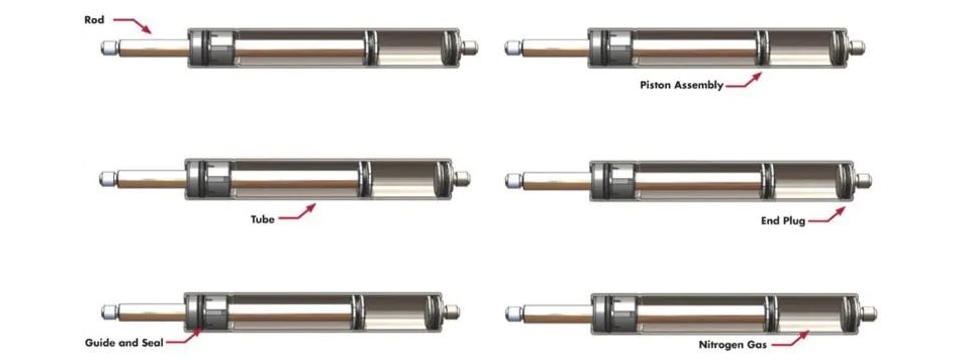Gas Springs 101: Understanding the Basics of Gas Spring Application
19.03.2023

Contact Today!
+90 212 671 88 00
19.03.2023
When it comes to choosing the right gas spring for your specific application, having a fundamental understanding of how they work and the terminology used is crucial. In this article, we'll provide recommendations and guidelines for different mounting positions, and explain the various orientation and damping effects that can be expected.
So, what exactly is a gas spring? In essence, it's a device that stores energy similarly to a mechanical coil spring, but instead of using straining material, it compresses gas to store energy. A gas spring is a self-contained system that requires no additional gas once charged with inert nitrogen gas during manufacture. The piston attached to the rod controls the flow of gas as the rod is extended or depressed, creating spring-like behavior.
Understanding Gas Spring Terminology: Common Terms to Know
When it comes to specifying a gas spring, there are a few key terms that you should be familiar with. These include stroke, extended length, closed length, and beadroll.
Stroke refers to the maximum distance that the rod can travel from the closed length to the extended length. Extended length, on the other hand, is the total length of the gas spring measured from the center of one end fit to the center of the next end fit. Closed length is the total length of the gas spring when it is in the closed position, measured from the center of one end fit to the center of the next end fit. Finally, beadroll is the grooved section of the tube that helps to retain the guide and seal package and prevent the piston from damaging the seal package during extension.
Discovering the Anatomy of a Gas Spring: Understanding Its Components
A gas spring is composed of several integral components that are crucial for its safe and effective operation. Figure below shows these components in detail.

The rod is a key component that can come in different materials such as precision-ground, polished carbon, or stainless steel. The surface of the rod is treated to improve wear resistance and increase corrosion resistance. It is typically longer than the stroke of the spring and shorter than the length of the tube. Carbon steel rods can undergo treatments like chrome-plating and salt-bath nitriding, which provide wear resistance, lower frictional characteristics, and corrosion resistance equivalent to stainless steel. The process is also environmentally friendly, non-toxic, and produces no acidic by-products.
The gas spring tube is made of a high-integrity powder-coated, carbon, or stainless steel seamless welded tube that is suitable for high pressures. The internal surface finish and tensile strength of the tube are critical factors that affect the gas spring's longevity and burst pressure performance.
Guide and Seal Package for Gas Springs. To ensure the proper functioning of gas springs, a guide and seal package is essential. This package, made from plastic composite, provides a bearing surface for the rod while also preventing gas from escaping and contamination from entering. In addition to plastic composite, guides for gas springs can also be made from zinc, brass, or other suitable materials with a bearing sleeve incorporated. Standard seals are made from rubber.
The piston assembly, which controls the extension and compression rate of the gas spring, is made from either zinc, aluminum, or plastic. The attachment between the piston and rod is crucial for safety reasons, preventing the rod from being expelled from the spring.
Finally, the end plug seals the tube end of the gas spring and attaches to the tube end fitting. The gas spring is charged with nitrogen, a nonflammable and inert gas that does not react with any internal components.
Damping in Gas Springs: Understanding Velocity Control and Its Factors
Gas springs rely on oil for more than just lubrication. Oil also provides velocity control at the end of the spring's extension stroke. Without damping control, rapid extension could lead to product failure, damage, or injury. To achieve damping, the flow of gas and oil through the piston must be regulated. When the gas spring is mounted in the preferred rod down position, maximum damping occurs when the piston reaches the oil damping zone near full extension. However, damping levels can be influenced by several factors:
Operating temperature: Higher temperatures increase force and decrease oil viscosity, leading to less damping. Lower temperatures do the opposite.
Oil viscosity: Higher viscosity oils have greater resistance and provide stronger damping. However, viscosity charts plot viscosity against temperature in a logarithmic function, so higher viscosity oils are subject to more pronounced changes in damping behavior with temperature fluctuations.
Tube diameter: Greater diameter means more fluid passing through the piston, resulting in greater damping effect.
Oil volume: More oil means earlier damping and slower extension speed.
Pour point: If the oil reaches the pour point, it becomes semi-solid, and no damping can occur. By understanding damping and its factors, you can choose the right gas spring for your application and ensure optimal performance.
Controlling Gas Spring Extension Speed: What You Need to Know
Metering is a crucial aspect of controlling the rate of extension and compression of a gas spring. Manufacturers use various techniques to achieve this, including altering the size of the piston orifice and creating restrictive flow paths through the piston. The goal is always the same: to create a pressure drop across the piston that controls the extension speed. Essentially, the larger the piston orifice or shorter the flow path, the faster the spring will extend.
However, breakaway friction, also known as stiction, can impact spring performance. When a spring is stationary for even a short period, the pressure within it can cause lubrication to migrate away f,rom the seals and into the minute cracks and crevices within the metal. This can lead to additional force being required to free the rubber from the cracks and crevices during the first cycle.